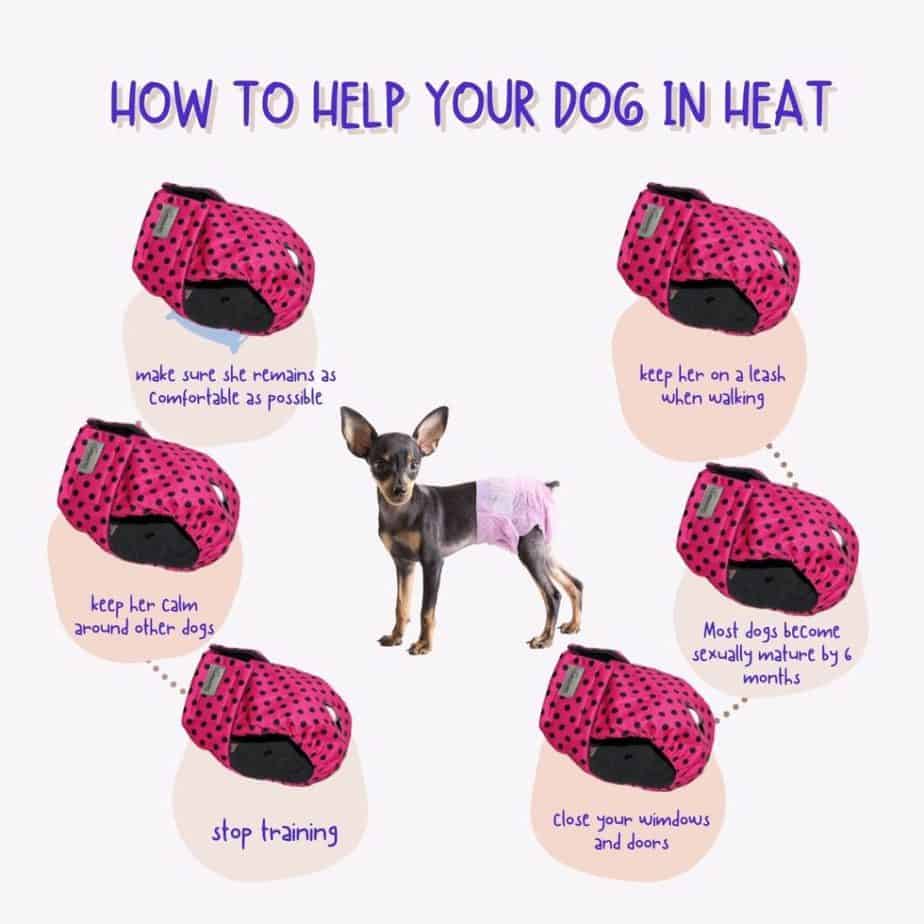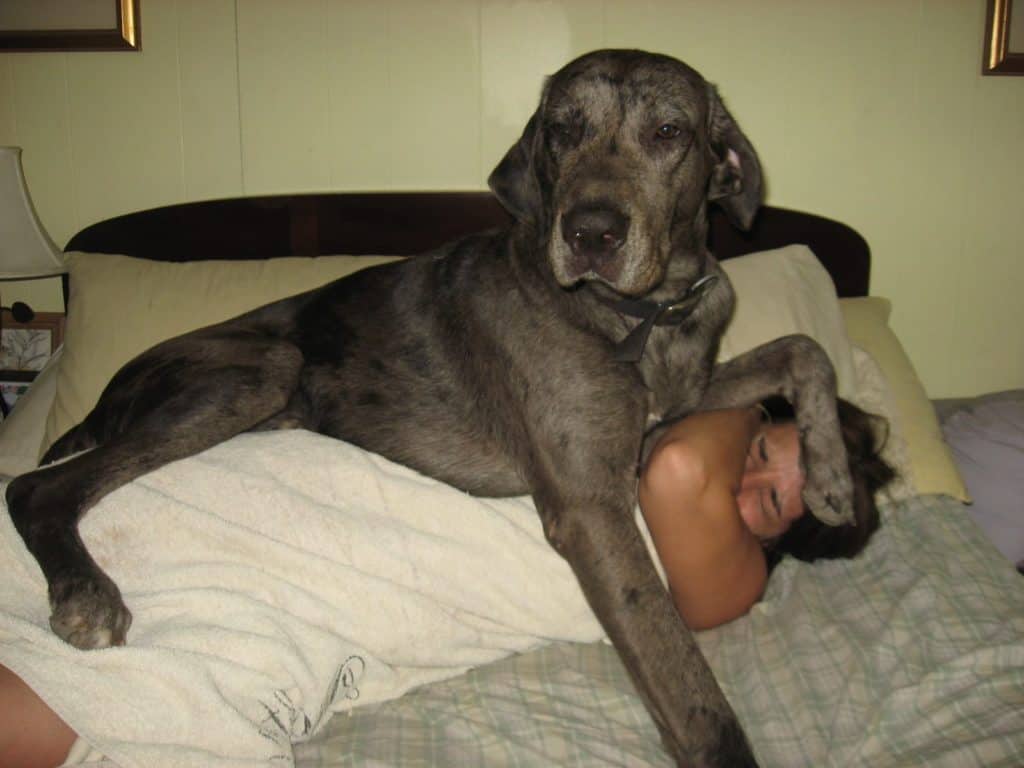Updated 30/12/2022
Dogs in heat bleed for approximately a week to 10 days. Some dogs bleed very heavily and others lightly.
As your female dog begins to grow up, one of the milestones you’ll need to deal with is its first heat. Just like teething, your dog’s first heat is a sign that they are maturing.
However, once your dog gets their first heat, it will be able to get pregnant and have a litter. So, you must keep an eye on your dog’s heats, especially the first one. But how long can you expect your dog’s heat to last? How can you care for your dog when they are in heat?
And, when do dogs in heat stop bleeding? Well, in this article, we aim to answer all the questions you could possibly have about heats. So, read on to become a more confident dog owner.
7 Signs of a dog in heat
1. Physically swollen vulva
2. Bleeding or discharge from the vulva
3. Increased urination
4. Restlessness, pacing, and mounting
5. Increased attention-seeking behavior
6. Flagging tail, which is when a dog holds its tail up and to the side
7. Aggression, particularly toward male dogs

When will my dog get her first heat?
Did you know that a dog’s sexual maturity is linked to its growth? Smaller dogs stop growing and thus become sexually mature, often at around 4 to 6 months, for example, while larger breed dogs sometimes have to wait at least 9 months before getting their first heat.
How often will my dog go into heat?
Once your dog has begun heats, they will keep going into heat about every six months from now on. The larger they are, the less frequent their heats are, with dogs like the Great Dane and St. Bernard only having heats every 12 to 18 months.
Don’t be alarmed if your dog’s heat cycles aren’t regular for the first few months or even years. It’s common for a dog’s cycle to take around two years to fully settle down.
What happens when my dog sexually matures?
The things that happen to your female dog as they become sexually mature are pretty similar to what humans go through. Your dog won’t get acne, but you may notice behavioral and mood changes.
During the first stage of your female dog’s heat, you may notice their vulva swelling a little. This first stage is called proestrus.
You may also see your female dog licking their vulva too. On top of this, you may spot a red, bloody discharge, though many female dogs groom themselves clean to the extent that their owner doesn’t notice they’re in heat.
Your female dog will pee more often during proestrus; it may feel like you’re letting them out into the yard every 5 minutes! They should produce discharge for anywhere from 7 to 10 days. But, they will actually be fertile for 2 to 3 weeks.
When will my dog stop bleeding?
Your female dog will be fertile for up to 3 weeks, as we mentioned earlier. You will have to keep them safely indoors for these entire 3 weeks, away from dogs who may want to mount them.
Thankfully, your female dog will likely want to fend off male dogs who approach them during their cycle. Since your female dog will only produce bloody discharge for 7 to 10 days max, they will stop bleeding about 10 days into their heat cycle.
How will I know when my dog’s heat cycle has ended?
In the very title of this article, the main sign that your dog’s cycle is beginning to end is, of course, that they have stopped producing bloody discharge. However, a better sign that your dog’s cycle has ended is that their vulva has stopped swelling and reduced to its normal size.
Again, your dog’s cycle probably won’t settle down for around two years. So, don’t be too alarmed if your dog keeps bleeding for even two weeks or they have intermittent bleeding. As well as this, don’t rely on our calculations to indicate your individual dog’s cycle.
How should I care for my dog during their heat?
As we touched upon earlier, the increase in hormonal activity can put your sexually mature puppy in danger. The scent of the female dog’s urine can tempt males to come running from miles around. So, what should you do about this?
One thing you can do is limit where your sexually mature female dog walks. Don’t take them to crowded dog parks, especially ones with lots of off-leash dogs around.
Instead, if you can, let your dog get their exercise in a private, secure, fenced, off-leash area. You could also play active games indoors or in the yard, as long as there are no other dogs nearby on the other side of the fence. That being said, it’s unlikely your female dog will feel much like playing during their heat.
When your female dog is in heat, it is also essential to keep them in private places when fertile if you don’t want your dog to get pregnant. You may also like to use a doggy diaper or covering to keep your furniture clean.
6 Common behaviours of a female dog in heat
1. Increased Urination: Female dogs in heat often urinate more frequently than normal in order to attract male dogs.
2. Flagging: Flagging is the act of a female dog lifting her tail to the side, exposing her genitalia, in order to attract the attention of a male dog.
3. Howling: Female dogs in heat may howl more often than usual in order to communicate her desire to mate.
4. Swelling of the Vulva: During the heat cycle, the female dog’s vulva may become swollen, which is a sign that they are ready to mate.
5. Aggression: Female dogs in heat may become more aggressive, especially when around male dogs.
6. Increased Affection: Female dogs in heat may also become more affectionate, seeking out human attention and interaction.
When should I spay my female dog?
If you aren’t planning on breeding your female dog, you’ll probably want to spay them at some point. But when is it safest to carry out this procedure?
Most veterinarians will advise you not to spay your dog before they are finished growing. This is because spaying your dog leads to a reduction in hormone levels. These reduced hormones can interfere with your dog’s growth, resulting in bone problems and other disorders.
That being said, it has been shown that neutering your dog early on can significantly reduce the risk of physical diseases like hip dysplasia, several different types of cancer, and cruciate ligament ruptures.
So, the jury’s still out on this. Sure, on the one hand, it’s important to spay your female dog as early on as possible if you want to reduce the risk of cancer and specific physical issues. But you still also want to ensure that your female dog is fully developed and finished growing.
Thankfully, physical maturity is easy to estimate with female dogs. Most owners decide to let at least one heat cycle to fully elapse before considering their female dog mature enough to be spayed.
Of course, if you want to breed your female dog, you will spay them much later. This is okay, too; every dog and situation are different. Get in touch with your veterinarian for the best advice for you.


